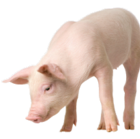Mycoplasma hyopneumoniae is the primary agent of porcine enzootic pneumonia. This disease reduces the performance of infected pigs (the decreased growth rate), increases feed conversion ratio & treatment expense and gives the potentiation of other respiratory tract pathogens. The severity of clinical signs and resultant economic loss varies between pigs and herds. Today, with the density of pigs in larger farms, the significance and severity of this infection has become a greater challenge.
A better understanding of the pathogen, of the role of immuity and of the methods on how to indentify problematic farms or herds, and not only problematic individuals, can help us to take the correct decisions in applying the reasonable preventive measures to improve the control of enzootic pneumonia.
So Ceva Animal Health Vietnam has the honour of providing the timely and useful informations relating to enzootic pneumonia to support the expert knowledge and suggest some solutions that can be applied.
Enjoy your reading!

Overview of porcine immune defenses and immunity to Mycoplasma hyopneumoniae infection >
The pig relies on multiple defenses to protect itself against microbial invasion. Understanding these immune defenses will help the producers to find the suitable solution to control the diseases in pig.

Mycoplasma hyopneumoniae: strain diversity and control measures >
Control measures for infections with Mycoplasma hyopneumoniae should focus on optimisation of management practices, and if these are not sufficient, antimicrobial medication and/or vaccination can be used, writes Dominiek Maes.

Mycoplasma hyopneumoniae - still a major challenge >
Mycoplasma hyopneumoniae cannot be ignored warns JOHN BAKER. Vaccination provides immediate improvement in the control of this costly disease and correcting problems in environment and management will increase the level of control provided by Mycoplasma vaccination.

 Corporate Website
Corporate Website
 Africa
Africa
 Argentina
Argentina
 Asia
Asia
 Australia
Australia
 Belgium
Belgium
 Brazil
Brazil
 Bulgaria
Bulgaria
 Canada (EN)
Canada (EN)
 Chile
Chile
 China
China
 Colombia
Colombia
 Denmark
Denmark
 Egypt
Egypt
 France
France
 Germany
Germany
 Greece
Greece
 Hungary
Hungary
 Indonesia
Indonesia
 Italia
Italia
 India
India
 Japan
Japan
 Korea
Korea
 Malaysia
Malaysia
 Mexico
Mexico
 Middle East
Middle East
 Netherlands
Netherlands
 Peru
Peru
 Philippines
Philippines
 Poland
Poland
 Portugal
Portugal
 Romania
Romania
 Russia
Russia
 South Africa
South Africa
 Spain
Spain
 Sweden
Sweden
 Thailand
Thailand
 Tunisia
Tunisia
 Turkey
Turkey
 Ukraine
Ukraine
 United Kingdom
United Kingdom
 USA
USA
 Vietnam
Vietnam



